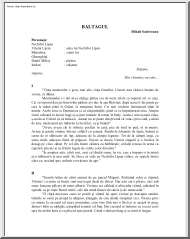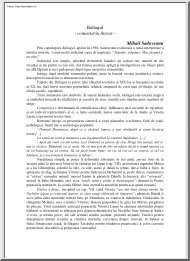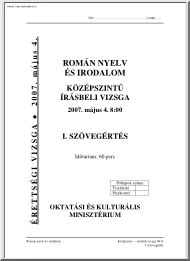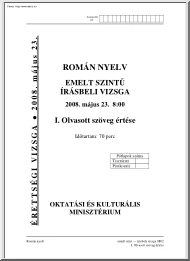Alapadatok
Év, oldalszám:2019, 4 oldal
Nyelv:angol
Letöltések száma:2
Feltöltve:2021. május 24.
Méret:684 KB
Intézmény:
-
Megjegyzés:
Tehnical College Traian Vuia, Oradea, Romania
Csatolmány:-
Letöltés PDF-ben:Kérlek jelentkezz be!
Nincs még értékelés. Legyél Te az első!
Tartalmi kivonat
Annals of the University of Oradea, Fascicle: Ecotoxicology, Animal Husbandry and Food Science and Technology, Vol. XVIII/B 2019 Analele Universitatii din Oradea, Fascicula: Ecotoxicologie, Zootehnie si Tehnologii de Industrie Alimentara, Vol.XVIII/B 2019 MODERN TEACHING STRATEGIES IN TEACHING ROMANIAN LANGUAGE AND LITERATURE Roşca Elena Florica* *Tehnical College „Traian Vuia ” Oradea, str. C Brancoveanu, nr 12/a, Oradea, Romania, email:roscaelena74@yahoocom Abstract The discourse on the reform of the current school refers, in particular, to the permanent renewal and improvement of the learning offer, which the system proposes to the student. In this sense, the aim of studying the Romanian language and literature during the compulsory schooling period is to train, progressively, a young man with a basic communication and literary culture, able to understand the world around him, to communicate and interact with his peers, to effectively integrate in the context of the future
school career, respectively professional. The student must efficiently and creatively use his own abilities to solve concrete problems in daily life, to be able to continue the learning process at any stage of his life .Nowadays, the emphasis is on procedural learning, on structuring modern strategies and procedures for problem solving, exploitation and investigation, characteristic of the communicative activity. Key words: interactive teaching methods, educational process , competences, methods, teacher, student , critical thinking, motivation. INTRODUCTION Romanian language and literature is a discipline through which the study aims to achieve specific objectives and competences, and the general aims would be: Forming a system of attitudes, values and behaviors focused on: strengthening the interest for learning and self-education; awareness of the spiritual and ethical values conveyed through language and literature; understanding the meaning of language - and spiritual creation,
in general in shaping national identity and integrating them into the universal; Formation of a set of knowledge regarding: language systems, as building blocks of efficient social communication; the diversity, the aesthetic value of the beletristic creations in the national and universal literature; Formation of intellectual capacities regarding: optimization of the operations of thought and development of specific creativity; The rational practice of the language in order to understand the structure and functionality of the language, as a unitary system , in permanent evolution; 289 The formation of cultural representations includes: developing the availability of reception of crisis, literary and non-literary mesages ; The acquisition of methods and techniques of intellectual work is progressively achieved by deepening the accumulated knowledge to which is added permanently new information. MATERIALS AND METHODS Starting from the premise that the Romanian language and
literature lesson must be a valuable one, from the perspective of the activeparticipative methods, of a formative type, in support of the development of the students knowledge, it is appropriate to emphasize a first finding, which refers to the achievement of operational objectives. cognitive and affective, through specific didactic strategies: learning by discovery, heuristic conversation, "bunny" method, dials, didactic game, "ice breaking", brainstorming, Venn diagrams, experiment, case study, project learning, activity on teams, etc., methods aimed at achieving general competences The teaching and learning methods specific to the Romanian language and literature are multiple. Brainstorming - can be done on a topic that has to do with the topic of the studied text or its key elements. Starting from the answers received, you can create a bunch of ideas that synthetically group the students answers. Examples: What do you think of when you hear / read the word
"fantastic", "romantic", etc.? Name a feature that you think is important for the pastoral era. The modern method of brainstorming, an active-participative group method, whose use in the didactic approach can last from 15 to 60 minutes, can be used successfully in the gymnasium, in the elaboration of free collective compositions, in approaching modern literary works, with finally open, in explaining polysemantism Quintet - a creative method, in which in five verses a content of ideas is synthesized. You can add a drawing The first verse is a key word about the discussion, being usually substantive. The second verse is made up of two words that describe the noun in question, being adjectives. The third verse is made up of three words that express an action, being, as a rule, verbs in the gerund mode. The fourth verse contains four words and expresses the feelings towards the subject. The fifth verse is a word that synthesizes those presented. Mutual teaching: if
students are put in the role of teachers, they have the opportunity to (re) learn what they thought they knew. When students teach their colleagues, they practice and develop their own way of arranging 290 teaching strategies. Mutual teaching can be done in groups of four to seven members and consists of the following: - all participants have a copy with the same text. They distribute their tasks and text; - all read the text and one of them summarizes it orally; - asks the others a question based on the text they will try to answer; - the student who "teaches" clarifies some things that are unclear to colleagues, at their request or on their own initiative; - the students will predict together the content of the next fragment and the role of the teacher will be taken by another student in the group; The steps the student must follow: summarize what he / she has read; ask a question to others about the paragraph read in order to clarify and understand it more clearly ;
predict / anticipate what will happen in the next fragment; Putting students in the position of teacher who teaches others diminishes teacher-student distance, creating an educational climate that is much more conducive to learning. RESULTS AND DISCUSSIONS From the number of methods presented and their descriptions, we must conclude that there are many ways to energize the education process and to remove the connotation of difficulties that the term of school education entails. Centering on the student means using the students experiential knowledge as an individual and creating conditions for sharing this knowledge with the other individuals who are trained or educated according to a mixed, individual and collective experience, thus increasing the degree of collective experience to all. members of the group It is good for a teacher to know and apply as many teaching methods as possible to avoid devaluation of the method by repetition. Therefore, active - participatory methods should
be used with caution. But the methods should not be ignored because they energize the learning process and motivate the students . CONCLUSION Participatory methods require a large number of hours to prepare lessons from the teacher, design efforts, time efforts, large materials and special measures to reduce the risk of unforeseen situations that would destroy the entire activity. That is why the teacher must have several alternatives to approach the lesson. The lesson itself might be felt to be too short for the correct teaching scenario to unfold. 291 I believe that such modern methods of learning-teaching, used with discernment and only to the extent that traditional methods are not neglected, improve the communication between students and that between students and teachers, creating positive attitudes, at the level of the class involved in the activity. In addition, through these educational experiences, students prepare for life, for their future activity, learning useful
things about teamwork, about responsibility, giving, seriousness, contributing to the common effort . REFERENCES 1. Bărboi Constanţa, Metodica predării limbii şi literaturii române în liceu, E. D P, Bucureşti, 1983 2. Cerghit, Ioan, Metode de învăţământ, Editura Polirom, Iași, 2006; 3. Cerghit, Ioan, (1997), Metode de învăţământ, Editura Didactică şi Pedagogică, Bucureşti; 4. Cristea C. Gabriela (2002), Pedagogie generală, Editura Didactică şi Pedagogică, Bucureşti; 5. Cucoş C., Padagogie, Ed Polirom, Iaşi, 1996 6. Dumitru Ioan, Dezvoltarea gândirii critice şi învăţarea eficientă, în colecţia Gândirea critică 7. Ioan Jinga, Elena Istrate, Manual de pedagogie, Ed. All, Bucureşti, 2001 8. 9. Miron Ionescu, Ioan Radu, 2004, Didactica modernă, Editura Dacia, Cluj Napoca; VasileMarcu, L.Filimon – Psihopedagogie pentru formarea profesorilor, Ed Univ Oradea, 2003. 292
school career, respectively professional. The student must efficiently and creatively use his own abilities to solve concrete problems in daily life, to be able to continue the learning process at any stage of his life .Nowadays, the emphasis is on procedural learning, on structuring modern strategies and procedures for problem solving, exploitation and investigation, characteristic of the communicative activity. Key words: interactive teaching methods, educational process , competences, methods, teacher, student , critical thinking, motivation. INTRODUCTION Romanian language and literature is a discipline through which the study aims to achieve specific objectives and competences, and the general aims would be: Forming a system of attitudes, values and behaviors focused on: strengthening the interest for learning and self-education; awareness of the spiritual and ethical values conveyed through language and literature; understanding the meaning of language - and spiritual creation,
in general in shaping national identity and integrating them into the universal; Formation of a set of knowledge regarding: language systems, as building blocks of efficient social communication; the diversity, the aesthetic value of the beletristic creations in the national and universal literature; Formation of intellectual capacities regarding: optimization of the operations of thought and development of specific creativity; The rational practice of the language in order to understand the structure and functionality of the language, as a unitary system , in permanent evolution; 289 The formation of cultural representations includes: developing the availability of reception of crisis, literary and non-literary mesages ; The acquisition of methods and techniques of intellectual work is progressively achieved by deepening the accumulated knowledge to which is added permanently new information. MATERIALS AND METHODS Starting from the premise that the Romanian language and
literature lesson must be a valuable one, from the perspective of the activeparticipative methods, of a formative type, in support of the development of the students knowledge, it is appropriate to emphasize a first finding, which refers to the achievement of operational objectives. cognitive and affective, through specific didactic strategies: learning by discovery, heuristic conversation, "bunny" method, dials, didactic game, "ice breaking", brainstorming, Venn diagrams, experiment, case study, project learning, activity on teams, etc., methods aimed at achieving general competences The teaching and learning methods specific to the Romanian language and literature are multiple. Brainstorming - can be done on a topic that has to do with the topic of the studied text or its key elements. Starting from the answers received, you can create a bunch of ideas that synthetically group the students answers. Examples: What do you think of when you hear / read the word
"fantastic", "romantic", etc.? Name a feature that you think is important for the pastoral era. The modern method of brainstorming, an active-participative group method, whose use in the didactic approach can last from 15 to 60 minutes, can be used successfully in the gymnasium, in the elaboration of free collective compositions, in approaching modern literary works, with finally open, in explaining polysemantism Quintet - a creative method, in which in five verses a content of ideas is synthesized. You can add a drawing The first verse is a key word about the discussion, being usually substantive. The second verse is made up of two words that describe the noun in question, being adjectives. The third verse is made up of three words that express an action, being, as a rule, verbs in the gerund mode. The fourth verse contains four words and expresses the feelings towards the subject. The fifth verse is a word that synthesizes those presented. Mutual teaching: if
students are put in the role of teachers, they have the opportunity to (re) learn what they thought they knew. When students teach their colleagues, they practice and develop their own way of arranging 290 teaching strategies. Mutual teaching can be done in groups of four to seven members and consists of the following: - all participants have a copy with the same text. They distribute their tasks and text; - all read the text and one of them summarizes it orally; - asks the others a question based on the text they will try to answer; - the student who "teaches" clarifies some things that are unclear to colleagues, at their request or on their own initiative; - the students will predict together the content of the next fragment and the role of the teacher will be taken by another student in the group; The steps the student must follow: summarize what he / she has read; ask a question to others about the paragraph read in order to clarify and understand it more clearly ;
predict / anticipate what will happen in the next fragment; Putting students in the position of teacher who teaches others diminishes teacher-student distance, creating an educational climate that is much more conducive to learning. RESULTS AND DISCUSSIONS From the number of methods presented and their descriptions, we must conclude that there are many ways to energize the education process and to remove the connotation of difficulties that the term of school education entails. Centering on the student means using the students experiential knowledge as an individual and creating conditions for sharing this knowledge with the other individuals who are trained or educated according to a mixed, individual and collective experience, thus increasing the degree of collective experience to all. members of the group It is good for a teacher to know and apply as many teaching methods as possible to avoid devaluation of the method by repetition. Therefore, active - participatory methods should
be used with caution. But the methods should not be ignored because they energize the learning process and motivate the students . CONCLUSION Participatory methods require a large number of hours to prepare lessons from the teacher, design efforts, time efforts, large materials and special measures to reduce the risk of unforeseen situations that would destroy the entire activity. That is why the teacher must have several alternatives to approach the lesson. The lesson itself might be felt to be too short for the correct teaching scenario to unfold. 291 I believe that such modern methods of learning-teaching, used with discernment and only to the extent that traditional methods are not neglected, improve the communication between students and that between students and teachers, creating positive attitudes, at the level of the class involved in the activity. In addition, through these educational experiences, students prepare for life, for their future activity, learning useful
things about teamwork, about responsibility, giving, seriousness, contributing to the common effort . REFERENCES 1. Bărboi Constanţa, Metodica predării limbii şi literaturii române în liceu, E. D P, Bucureşti, 1983 2. Cerghit, Ioan, Metode de învăţământ, Editura Polirom, Iași, 2006; 3. Cerghit, Ioan, (1997), Metode de învăţământ, Editura Didactică şi Pedagogică, Bucureşti; 4. Cristea C. Gabriela (2002), Pedagogie generală, Editura Didactică şi Pedagogică, Bucureşti; 5. Cucoş C., Padagogie, Ed Polirom, Iaşi, 1996 6. Dumitru Ioan, Dezvoltarea gândirii critice şi învăţarea eficientă, în colecţia Gândirea critică 7. Ioan Jinga, Elena Istrate, Manual de pedagogie, Ed. All, Bucureşti, 2001 8. 9. Miron Ionescu, Ioan Radu, 2004, Didactica modernă, Editura Dacia, Cluj Napoca; VasileMarcu, L.Filimon – Psihopedagogie pentru formarea profesorilor, Ed Univ Oradea, 2003. 292



